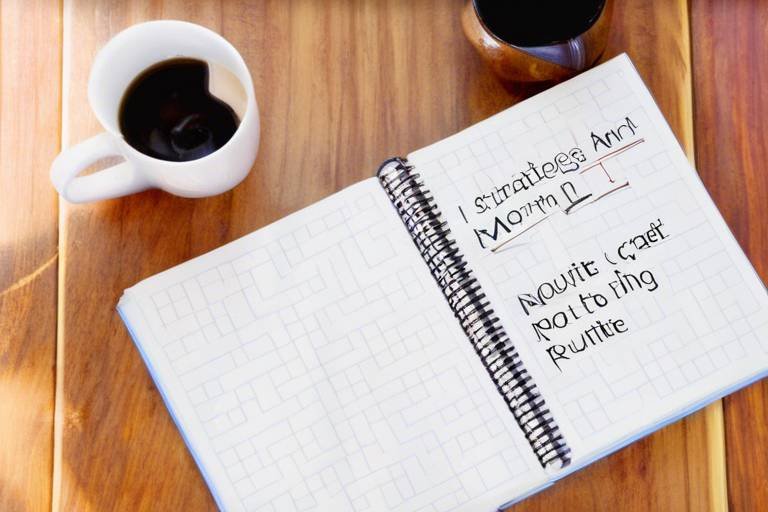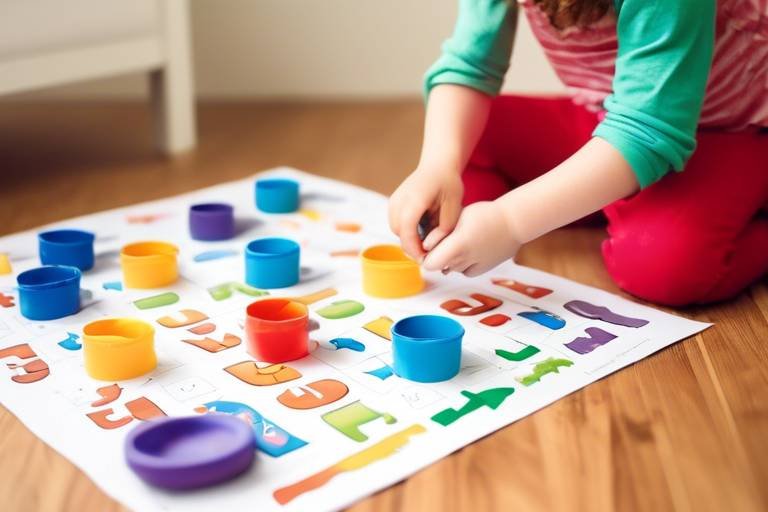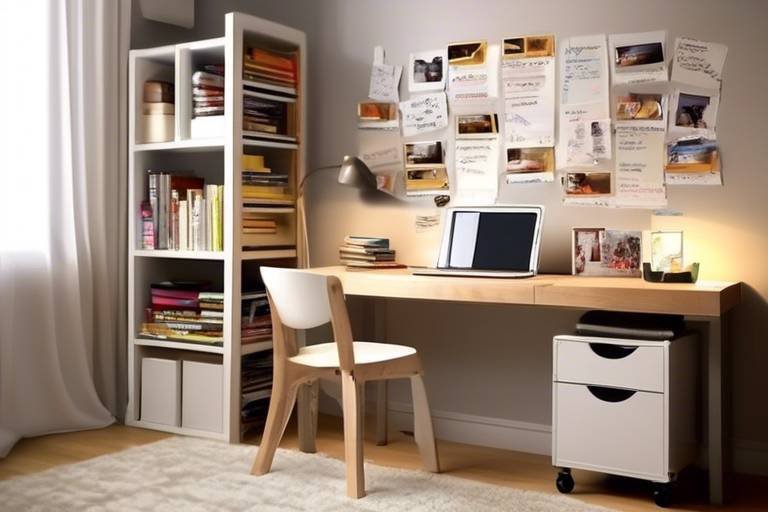Understanding the Importance of Space in Family Life
In today's fast-paced world, where life can often feel like a whirlwind, the concept of personal space within family life is more important than ever. Personal space isn't just about having a physical area to call your own; it's about creating an environment where each family member can thrive, feel respected, and grow individually while still being part of a cohesive unit. Imagine a garden where each plant has its own space to grow—too close together, and they’ll compete for resources, but with enough room, they flourish beautifully. This analogy applies perfectly to families. Just as plants need space to thrive, so do family members.
Understanding the dynamics of personal space can significantly influence family relationships. It’s crucial to recognize that every individual has unique needs and comfort levels regarding their personal space. This can vary widely from one person to another, making it essential for families to communicate openly about their feelings and boundaries. When personal space is respected, it leads to a healthier family dynamic, where everyone feels valued and understood. But what does it mean to truly respect personal space? It involves recognizing verbal and non-verbal cues, being mindful of each other's needs, and allowing for moments of solitude without guilt or resentment. This balance fosters an environment where love and support can flourish.
Moreover, the impact of personal space extends beyond just individual comfort; it plays a significant role in emotional well-being. When family members feel they have the freedom to express themselves without fear of judgment or interruption, it leads to improved communication. Think about it: have you ever tried to have a deep conversation in a cramped, noisy space? It’s nearly impossible! Creating a home where personal space is honored means that family discussions can happen in a calm, open atmosphere, paving the way for deeper connections and understanding.
Furthermore, personal space is not just about physical distance; it also encompasses emotional boundaries. Each family member should feel secure in expressing their feelings, whether they are joyful, sad, or frustrated. When emotional boundaries are respected, family members are more likely to share their thoughts and feelings openly, leading to stronger bonds. This can be particularly important during challenging times, where support and understanding are crucial. So, how do we cultivate this kind of environment? It starts with active listening and empathy, which are key ingredients in any healthy relationship.
In conclusion, the importance of personal space in family life cannot be overstated. It’s about finding that sweet spot between togetherness and solitude, enabling each member to pursue their interests while also nurturing family bonds. By fostering an atmosphere of respect and understanding, families can create a harmonious environment that not only supports individual growth but also strengthens the family unit as a whole. After all, a family that understands the importance of personal space is a family that thrives together.
- What is personal space? Personal space refers to the physical and emotional boundaries that individuals keep to feel comfortable and secure.
- Why is personal space important in families? It helps in reducing stress, improving communication, and fostering independence among family members.
- How can families create a balanced environment? By setting clear boundaries and designing functional spaces within the home that allow for both togetherness and solitude.
- What role does communication play in respecting personal space? Open communication helps family members express their needs and boundaries, leading to better understanding and respect.

The Concept of Personal Space
When we talk about personal space, we’re diving into a realm that’s both physical and emotional. Imagine a bubble surrounding each person—this bubble represents their personal space, a protective barrier that helps maintain comfort and individuality. In a family setting, understanding this concept is crucial. Each member of the family has their own unique needs and preferences when it comes to space, and recognizing these can lead to a more harmonious household.
Personal space isn’t just about the distance we keep from one another; it also encompasses how we feel emotionally. For instance, some people might feel overwhelmed in crowded settings, while others thrive in close quarters. This variability is influenced by factors such as personality, upbringing, and even cultural background. Acknowledging these differences is essential for fostering a supportive family environment.
In practice, personal space can manifest in various ways. Here are a few aspects to consider:
- Physical Boundaries: This includes the actual distance we maintain from others. For example, some people may prefer a few feet of space while engaging in conversation, while others might feel comfortable standing close.
- Emotional Boundaries: These relate to how much personal information we share and how we express our feelings. Some family members might be open books, while others may prefer to keep their emotions private.
- Time Boundaries: Everyone needs time to recharge. Recognizing when someone needs a little alone time can be a game changer for family dynamics.
Understanding personal space is like learning to dance. If one partner steps on the other’s toes, the rhythm is disrupted. Similarly, when family members respect one another’s boundaries, the family dynamic flows smoothly. When personal space is invaded, it can lead to feelings of discomfort, frustration, and even conflict.
In essence, personal space is vital for maintaining a healthy family environment. It allows each member to feel secure, respected, and valued. By grasping the importance of personal space, families can create a nurturing atmosphere where everyone can thrive, both together and individually.

Benefits of Personal Space in Families
When we think about family life, we often picture togetherness, laughter, and shared experiences. However, personal space plays a crucial role in maintaining a healthy family dynamic. Just like a garden needs room for each plant to grow, families thrive when each member has their own space to breathe and flourish. This concept might seem simple, but the benefits it brings to family relationships can be profound.
First and foremost, personal space contributes significantly to emotional well-being. When family members have the opportunity to retreat to their own spaces, they can recharge and reflect on their thoughts and feelings. This time alone can lead to reduced stress levels. Imagine coming home after a long day and being able to unwind in your favorite chair, away from the hustle and bustle of family life. It’s like hitting the reset button on your emotions!
Moreover, having personal space enhances communication within the family. When individuals feel comfortable and respected in their environment, they are more likely to express their thoughts openly. This leads to deeper understanding and connection among family members. For example, when a teenager knows they can have their room to themselves, they feel more at ease discussing their feelings about school or friendships during family dinners. It’s a win-win situation!
Effective communication is the cornerstone of any healthy relationship, and personal space is a vital component of this. When family members respect each other’s boundaries, it creates an atmosphere conducive to active listening. This means that conversations can flow more freely, without interruptions or distractions that often come from being in close quarters. Picture a family sitting together in the living room: if everyone is on top of each other, it’s easy for conversations to get lost in the chaos. But when each person has their own space, they can engage in meaningful discussions without feeling overwhelmed.
Active listening becomes a natural part of family interactions when personal space is honored. When individuals feel comfortable in their surroundings, they can focus entirely on the speaker without the noise of others vying for attention. This leads to a more profound connection, as family members truly hear and understand one another. It’s like tuning into your favorite radio station: when the signal is clear, the music is beautiful, but when there’s interference, all you get is noise.
Another significant benefit of respecting personal space is its impact on conflict resolution. When disagreements arise, having the ability to step away and collect one’s thoughts can be invaluable. Family members who feel secure in their environment are more likely to approach discussions calmly and thoughtfully. Instead of escalating arguments, they can take a moment to cool off and then return to the conversation with a clearer mindset. Think of it as allowing the steam to escape from a pressure cooker—when the pressure is released, you can address the situation without it exploding.
In addition to emotional benefits, personal space also fosters independence. When family members are allowed their own space, they can pursue individual interests and hobbies, which is essential for personal growth. This independence helps build self-confidence and allows family members to cultivate their identities outside the family unit. For instance, a child who has their own space to explore art or music can develop skills and passions that enrich their life and the family dynamic.
In summary, the benefits of personal space in families are multifaceted. From enhancing communication to promoting emotional well-being and encouraging independence, personal space is not just a luxury—it’s a necessity. By recognizing and respecting each family member's need for space, families can create a nurturing environment where everyone can thrive.
- What is personal space? Personal space refers to the physical and emotional boundaries individuals maintain, allowing them to feel comfortable and respected.
- How does personal space affect family dynamics? Personal space helps reduce stress, enhances communication, and fosters independence, leading to stronger family bonds.
- Can too much personal space be a problem? While personal space is essential, a balance between solitude and togetherness is crucial for maintaining family harmony.
- How can families create personal space at home? Families can designate specific areas for relaxation and personal activities, ensuring that everyone has the opportunity to recharge.

Enhancing Communication
When it comes to family life, communication is the lifeblood that keeps relationships thriving. But how can we enhance this vital aspect of our interactions? The answer often lies in respecting personal space. Imagine trying to have a conversation with someone while standing on their toes; it’s uncomfortable and distracting, right? Just like that, when family members are crowded together without consideration for personal space, it can lead to misunderstandings and frustration. By allowing each other some room to breathe, family members can engage in more meaningful conversations.
Respecting personal space creates an atmosphere where individuals feel comfortable expressing their thoughts and emotions. For instance, think about a teenager who may feel overwhelmed by their parents' constant presence. If given a little space, they might open up about their day or share their worries without the fear of being judged or interrupted. This dynamic fosters a deeper understanding among family members, paving the way for stronger connections.
Moreover, when personal space is honored, it encourages active listening. This means that family members can truly focus on what others are saying without the distractions that often come from being too close for comfort. Active listening is not just hearing words; it’s about understanding the emotions behind them. When you have your own space, you can process what’s being said, reflect on it, and respond thoughtfully. This practice not only enhances communication but also builds trust and respect within the family unit.
In addition to improving daily conversations, respecting personal space can play a crucial role in conflict resolution. Think about it: when tensions rise, emotions can run high, and having a little distance can make all the difference. When individuals feel secure in their environment, they are more likely to approach conflicts calmly and thoughtfully. Instead of shouting over each other or escalating the situation, family members can take a step back, gather their thoughts, and return to the discussion with a clearer mindset. This approach can lead to more productive resolutions and a greater sense of harmony within the family.
In essence, enhancing communication through personal space isn’t just about physical distance; it’s about creating an environment where every family member feels valued and heard. It’s about nurturing relationships that thrive on understanding, respect, and love. So, the next time you find yourself in a conversation with your family, consider the space around you. Are you giving each other enough room to express yourselves? If not, it might be time to reevaluate how personal space plays a role in your family dynamics.
- What is personal space? Personal space refers to the physical and emotional boundaries that individuals maintain to feel comfortable and secure.
- Why is personal space important in families? It promotes emotional well-being, reduces stress, enhances communication, and fosters individual growth.
- How can I encourage personal space in my family? By setting clear boundaries, designing functional spaces, and respecting each other's needs for solitude and togetherness.

Active Listening
Active listening is more than just hearing words; it’s about truly understanding the message being conveyed. Imagine sitting in a crowded room, where everyone is talking over each other. It’s chaotic, right? Now, picture a cozy corner where two people are engaged in a deep conversation, fully focused on one another. This is the magic of active listening, and it flourishes in an environment where personal space is respected. When family members have their own space, they can engage in conversations without feeling rushed or overwhelmed.
In a family setting, active listening fosters deeper connections. When someone feels that their thoughts and feelings are valued, they are more likely to open up. This creates a safe haven for communication, allowing each member to express their feelings without the fear of being interrupted or dismissed. It’s like a dance; when one partner leads gracefully, the other follows suit, creating a beautiful rhythm of understanding.
To enhance active listening in your family, consider the following strategies:
- Maintain Eye Contact: This shows that you are engaged and interested in what the other person is saying.
- Reflect Back: Paraphrase what the speaker has said to confirm your understanding and show that you’re paying attention.
- Avoid Interruptions: Allow the speaker to finish their thoughts before responding, which demonstrates respect for their viewpoint.
By implementing these strategies, family members can create a nurturing environment that promotes active listening. This not only aids in understanding but also strengthens the emotional bonds within the family. When each member feels heard and respected, it cultivates a sense of belonging and trust. Just like a sturdy bridge, the connections built through active listening can withstand the tests of time and conflict.
In conclusion, the practice of active listening is vital for healthy family dynamics. It requires a commitment to respecting personal space and valuing each other’s perspectives. By prioritizing active listening, families can navigate challenges more effectively, leading to a harmonious and supportive atmosphere.
- What is personal space? Personal space refers to the physical and emotional boundaries that individuals maintain to feel comfortable and secure.
- How does personal space affect family relationships? Personal space helps reduce stress and enhances communication, leading to stronger family bonds.
- What are some signs that personal space is being violated? Signs can include feelings of discomfort, anxiety, or frustration when interacting with family members.
- How can I encourage active listening in my family? Encourage eye contact, reflect back what you hear, and avoid interruptions during conversations.

Conflict Resolution
Conflict is a natural part of family life, much like the occasional storm that rolls through a sunny day. However, how families navigate these conflicts can make all the difference in maintaining a harmonious environment. One of the most significant ways to manage conflicts effectively is by respecting each other's personal space. When family members feel they have the freedom to express themselves without fear of being overwhelmed or judged, they are more likely to approach disagreements with a calm and rational mindset.
Imagine a scenario where a teenager feels overwhelmed by their parents' constant presence during a stressful homework session. If they are given the space to tackle their challenges independently, they can process their emotions and thoughts more clearly. This space allows them to return to the conversation with a level head, making it easier to discuss their feelings and concerns without escalating tensions. In this way, personal space acts as a buffer, allowing individuals to collect their thoughts and approach conflict with empathy and understanding.
Furthermore, when family members respect personal space, it encourages a culture of active listening. This means that when a disagreement arises, each person is more likely to truly hear what the other is saying, rather than simply waiting for their turn to speak. This kind of engagement fosters deeper connections and leads to more effective conflict resolution. Here are some key points to consider:
- Emotional Safety: When individuals feel secure in their personal space, they are more inclined to share their true feelings, which is vital for resolving conflicts.
- Time to Reflect: Taking a step back provides the opportunity to reflect on the situation, leading to more thoughtful responses rather than reactive ones.
- Establishing Trust: Respecting personal space builds trust among family members, making them feel valued and understood, which is essential during conflicts.
In conclusion, the art of conflict resolution in families hinges on the delicate balance of personal space and open communication. By fostering an environment where each member can express their needs and feelings without fear of judgment, families can transform conflicts into opportunities for growth and understanding. After all, just like a well-tended garden, relationships flourish when nurtured with respect and care.
- What is personal space? Personal space refers to the physical and emotional boundaries that individuals maintain to feel comfortable and respected.
- How does personal space affect family dynamics? Personal space helps reduce stress, enhances communication, and fosters individual growth, leading to healthier family interactions.
- What are some signs that personal space is being violated? Signs may include feelings of discomfort, frustration, or a sense of being overwhelmed in close quarters.
- How can families establish boundaries? Families can establish boundaries by communicating openly about their needs and preferences regarding personal space.
- Why is active listening important in conflict resolution? Active listening promotes understanding and empathy, which are crucial for resolving conflicts effectively.

Encouraging Independence
Encouraging independence within a family is like nurturing a garden; it requires patience, understanding, and the right conditions to flourish. When family members are given the opportunity to carve out their own space—both physically and emotionally—they can explore their interests and develop unique identities. This independence is crucial for personal growth and self-confidence, allowing each individual to thrive without feeling overshadowed by the collective family dynamic. Just like a tree needs space to grow its branches, children and even adults need the freedom to explore their own paths.
One of the most effective ways to foster independence is by allowing each family member to pursue their own hobbies and interests. Whether it's painting, playing a musical instrument, or engaging in sports, having the freedom to explore these passions can lead to a sense of accomplishment and self-worth. When family members are encouraged to take time for themselves, they not only grow as individuals but also bring new experiences and perspectives back to the family unit. This exchange can strengthen relationships, as members share their newfound interests and achievements with one another.
Moreover, independence in a family setting cultivates responsibility. When individuals are given their own space, they begin to understand the importance of taking care of their surroundings and managing their time effectively. For example, a teenager who has their own room learns the value of keeping it tidy, which translates into other areas of their life, such as schoolwork and personal relationships. This sense of responsibility can be a powerful motivator, instilling a sense of pride in their accomplishments.
However, it's essential to strike a balance between independence and family involvement. Too much solitude can lead to feelings of isolation, while too little can create a sense of suffocation. Therefore, open communication about personal needs is vital. Family meetings can serve as a platform for discussing individual desires for space and activities. This dialogue not only encourages independence but also reinforces the idea that each family member’s voice matters, fostering a sense of belonging and respect.
In summary, encouraging independence is about creating an environment where family members feel safe to explore who they are outside of the family identity. By nurturing their individual interests, promoting responsibility, and maintaining open lines of communication, families can cultivate a healthy balance that benefits everyone involved. This balance not only enriches individual lives but also strengthens the family bond as a whole.
- Why is personal space important in a family? Personal space is crucial as it helps family members feel comfortable and respected, leading to healthier relationships and reduced stress.
- How can I encourage my children to be more independent? Provide opportunities for them to explore their interests, allow them to make decisions, and encourage responsibility in managing their personal space.
- What are some signs that a family member needs more personal space? Signs may include irritability, withdrawal from family activities, or expressing a desire for alone time.
- How can we balance quality time and personal space in our family? Schedule regular family activities while also setting aside individual time for each member to pursue their interests.

Creating a Balanced Family Environment
Creating a balanced family environment is essential for nurturing strong relationships and promoting individual growth. Imagine a seesaw; if one side is too heavy, it tips over, causing chaos. Similarly, in family life, a lack of balance between personal space and quality time can lead to misunderstandings and tension. It's crucial to find that sweet spot where everyone feels valued and understood, allowing for both togetherness and solitude.
One effective way to achieve this balance is by setting boundaries. Establishing clear boundaries helps family members articulate their needs for space and privacy. When everyone knows what's expected, it fosters an atmosphere of mutual respect. For instance, a simple rule like "knock before entering" can go a long way in helping family members feel secure in their personal space. This practice not only prevents feelings of suffocation but also encourages open dialogue about individual needs.
Moreover, designing functional spaces within the home can significantly enhance the family dynamic. Think of your home as a canvas where each family member can paint their own corner. Creating designated areas for relaxation and personal activities allows everyone to unwind and recharge. For example, a cozy reading nook or a hobby corner can serve as personal retreats that cater to individual interests. This thoughtful design promotes both togetherness and solitude, ensuring that the family unit remains cohesive while respecting personal boundaries.
To illustrate the importance of creating these spaces, consider the following table that outlines different areas of the home and their potential uses:
| Area of the Home | Potential Uses |
|---|---|
| Living Room | Family gatherings, game nights, and movie marathons |
| Home Office | Work, study, and personal projects |
| Backyard or Garden | Outdoor activities, relaxation, and gardening |
| Bedrooms | Personal time, sleep, and self-reflection |
By thoughtfully designing these spaces, families can enjoy the best of both worlds. They can come together for shared experiences while also having the opportunity to retreat and recharge individually. This balance is not just beneficial; it’s essential for maintaining a healthy family dynamic.
In conclusion, creating a balanced family environment requires intentional effort and open communication. By setting boundaries and designing functional spaces, families can cultivate an atmosphere that promotes both individual growth and collective harmony. Remember, it's all about finding that equilibrium where everyone feels comfortable, respected, and loved.
Q: How can I tell if my family needs more personal space?
A: If you notice increased tension, frequent arguments, or a general sense of discomfort among family members, it may be time to evaluate your family's needs for personal space.
Q: What are some signs that personal space is being respected?
A: Signs include open communication, willingness to listen, and a general feeling of comfort when discussing individual needs and preferences.
Q: How can we create personal space in a small home?
A: Use furniture to create defined areas, such as placing a bookshelf to divide a room or using curtains to create a cozy nook. Even small adjustments can make a significant difference.

Setting Boundaries
Setting boundaries within a family is akin to establishing a roadmap that guides each member on how to navigate their relationships with one another. These boundaries are not just lines drawn in the sand; they represent the emotional and physical space that each person needs to feel secure and valued. Imagine a garden where each plant has its own space to grow—if they are too close together, they might suffocate, but with the right distance, they can thrive. Similarly, when family members respect each other's boundaries, they foster an environment where everyone can flourish.
To effectively set boundaries, it’s essential to have open and honest conversations about each individual's needs. This process can be enlightening and may reveal aspects of family dynamics that were previously overlooked. For instance, one family member might need quiet time after a long day, while another might require a space to pursue a hobby without interruptions. By discussing these needs openly, families can create a culture of respect and understanding.
Establishing boundaries is not a one-time event; it requires ongoing communication and adjustment. Just like a ship adjusting its sails to navigate changing winds, families must be flexible and willing to revisit their boundaries as circumstances evolve. Regular family meetings can be a great way to check in with each other, ensuring that everyone feels comfortable and heard. During these meetings, family members can express any feelings of discomfort or the need for adjustments in their personal space.
Moreover, it’s crucial to remember that boundaries should be mutual. Just as one person sets a boundary, others must respect it. This reciprocity fosters a sense of trust and cooperation within the family unit. For example, if one sibling requests time alone in their room, it’s vital for the others to respect that request without taking it personally. This understanding helps to avoid unnecessary conflicts and builds stronger relationships.
In practical terms, setting boundaries can involve specific actions, such as:
- Designating quiet times during the day when everyone can retreat to their personal spaces.
- Creating a family calendar to schedule shared activities while also marking out individual time.
- Encouraging each family member to express their comfort levels regarding physical proximity during conversations.
Ultimately, setting boundaries is about creating a family environment where everyone feels safe, respected, and valued. It’s a delicate balance of togetherness and individuality, allowing each member to shine in their unique way while still being part of a cohesive unit. Just as a well-tended garden flourishes with the right care, a family that honors personal space will grow stronger and more connected over time.
Q1: What are personal boundaries?
A: Personal boundaries are the limits and rules we set for ourselves within relationships. They help define how we want to be treated by others and what we are comfortable with.
Q2: How can I communicate my boundaries effectively?
A: Start by being clear and direct about your needs. Use "I" statements to express how certain behaviors affect you, and be open to feedback from others.
Q3: What should I do if my boundaries are not being respected?
A: It’s important to address the issue calmly. Reiterate your boundaries and explain why they are important to you. If necessary, seek support from a family member or professional.
Q4: Can boundaries change over time?
A: Yes, boundaries can evolve as relationships grow and change. Regular check-ins with family members can help ensure everyone’s needs are still being met.

Designing Functional Spaces
When it comes to family life, the way we design our spaces can profoundly impact our daily interactions and overall harmony. Think of your home as a canvas; how you choose to fill it can either enhance or hinder the flow of family dynamics. Designing functional spaces means creating areas that cater to both togetherness and solitude, allowing family members to thrive individually while still enjoying shared moments together.
Imagine a home where each room serves a purpose, not just as a physical space but as a sanctuary for personal growth and family bonding. For instance, a cozy reading nook can become a retreat for a family member seeking a quiet moment, while a vibrant living room can serve as the heart of family gatherings. The key is to ensure that these spaces are not just aesthetically pleasing but also functional, promoting a sense of well-being for everyone.
One effective way to achieve this balance is by incorporating designated areas within the home. Here are some ideas to get you started:
- Personal Zones: Create small, personalized corners in bedrooms or shared spaces where individuals can engage in hobbies or relaxation. This could be a small desk for studying, a craft area, or a meditation corner.
- Multi-Functional Rooms: Design rooms that can serve various purposes. A guest room that doubles as a home office or a playroom that can be transformed into a quiet study area can maximize the utility of your space.
- Outdoor Spaces: Don't forget about the outdoors! A garden or patio can serve as a peaceful escape for reflection or family gatherings, depending on the occasion.
Moreover, the layout of your home plays a crucial role in how family members interact. Open floor plans can encourage togetherness, while strategically placed walls or partitions can provide the necessary privacy when needed. It’s all about finding that sweet spot where everyone feels comfortable. Consider using furniture arrangements that promote conversation while also allowing for personal space; for example, a circular seating arrangement in the living room can invite discussion while still leaving room for individual comfort.
Ultimately, designing functional spaces within your home is about creating an environment that respects and nurtures personal space while fostering family connections. It’s about making choices that reflect the needs and preferences of all family members, ensuring that everyone feels valued and understood. When each person has a space that feels like their own, the entire family benefits from improved communication, reduced stress, and a deeper sense of belonging.
Q: How can I ensure my children have enough personal space at home?
A: Consider creating designated areas in their rooms for activities they enjoy, such as reading, crafting, or playing. Encourage them to personalize these spaces to make them feel more comfortable.
Q: What are some signs that my family needs more personal space?
A: If you notice increased tension, frequent conflicts, or members feeling overwhelmed, it might be time to reassess your home layout and ensure everyone has their own space to recharge.
Q: How can I balance family time with the need for personal space?
A: Schedule regular family activities while also setting aside time for individual pursuits. This balance allows for meaningful connections while respecting everyone’s need for solitude.
Frequently Asked Questions
- What is personal space and why is it important in family life?
Personal space refers to the physical and emotional boundaries that individuals maintain. It's crucial in family life because it helps each member feel comfortable and respected, allowing for healthier interactions and relationships.
- How does personal space benefit family communication?
When family members respect each other's personal space, it enhances communication. Individuals feel more at ease sharing their thoughts and feelings, leading to better understanding and deeper connections among family members.
- Can personal space reduce family conflicts?
Absolutely! Respecting personal space can aid in conflict resolution. When individuals feel secure in their environment, they are more likely to approach discussions calmly and thoughtfully, which helps in resolving disagreements more effectively.
- How can I encourage my family members to respect personal space?
Establishing clear boundaries is key. Communicate openly about each person's need for space, and encourage mutual respect. This practice can prevent feelings of suffocation or neglect, fostering a more harmonious family environment.
- What are some ways to create functional spaces at home?
Designate specific areas within your home for relaxation and personal activities. This could be a cozy reading nook or a quiet corner for hobbies. Thoughtful design promotes both togetherness and solitude, benefiting the entire family dynamic.
- How does personal space contribute to individual growth?
Providing personal space allows family members to pursue their interests and develop self-confidence. It helps them cultivate their identities outside the family unit, leading to more well-rounded individuals.



















